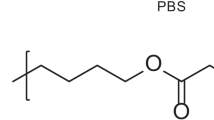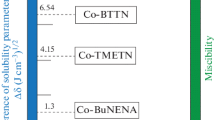Summary
The diffusion of C.I. direct orange 34(MW=299) and benzoic acid(MW=122) through degraded semicrystalline polyethylene glycol(PEG)/poly(L-lactide)(PLLA) block copolymers with various PEG contents and PEG segment lengths at 37°C was studied by UV-visible spectroscopy, differential scanning calorimetry(DSC), wide angle X-ray diffractometer (WAXS) and scanning electron microscopy(SEM). The influences of the PEG contents, PEG segment lengths and hydrolytic degradation of PEG/PLLA copolymers on the solute diffusion coefficient and mode for transport were investigated. It is concluded that the diffusion rate increases with the increase of PEG contents and PEG segment lengths in PEG/PLLA copolymers. This is understandable that the increase of PEG content and PEG segment length both make the degree of crystallinity decrease. The steady state of mass flux could not be reached at the diffusion times up to 1000 h, because the copolymers underwent hydrolysis reaction during this period. Furthermore, it is understood that the characteristic time of diffusion as defined by the square of film thickness at an instant of time over the diffusion coefficient of solute through polymer decreases with the increasing diffusion time.
Similar content being viewed by others
References
E.E. Schmitt and R.A. Polistina, U.S. Pat. 3297033 (1967).
D.K. Gilding and A.M. Reed,Polymer, 20, 1459 (1979).
T. Ueda, Y. Takebayaski, Y. Tabata and Y. Ikada,Polymer Preprints (Japan),39, 582 (1990).
B. Eling, S. Gogolewski and A.J. Pennings,Polymer, 23, 1587 (1982).
B. Kalb and A.J. Pennings,Polymer, 21, 607 (1980).
A.R. Miller, J.M. Brady and D.E. Cutright,J. Biomed. Mater. Res. 11, 711 (1977).
A.M. Reed and D.K. Gilding,Polymer, 22, 499 (1981).
Y. Kimura, Y. Matsuzaki, H. Yamane and T. Kitao,Polymer, 30, 1342 (1989).
D. Cohn and H. Younes,J. Biomed. Mater. Res., 21, 993 (1986).
S.J. Holland, B.J. Tighe and P.L. Gould,J. Controlled Release, 4, 155 (1986).
R.S. Harland and N.A. Peppas,Colloid & Polymer Science, 267, 218 (1989).
K.J. Zhu, B. H. Song and S.L. Yang,J. Polym. Sci.: Part A:Polym. Chem., 27, 2151 (1989).
K.J. Zhu, X. Z. Lin and S.L. Yang,J. Appl. Polym. Sci., 39, 1 (1990).
J Crank (ed.), “The Mathematics of Diffusion”, Oxford University Press 1975, chap.4, pp.52.
S. RabiejEur. Polym. J., 27, 947, (1991).
D.S.-G. Hu and H. J. Liu,Polymer Bulletin, 30(6), 669(1993).
M. Vert, S. Li and H. Garreau,J. Controlled Release, 16, 15 (1990).
Author information
Authors and Affiliations
Rights and permissions
About this article
Cite this article
Liu, HJ., Hsieh, CT. & Hu, D.SG. Solute diffusion through degradable semicrystalline polyethylene glycol/poly(l-lactide) copolymers. Polymer Bulletin 32, 463–470 (1994). https://doi.org/10.1007/BF00587889
Accepted:
Issue Date:
DOI: https://doi.org/10.1007/BF00587889




